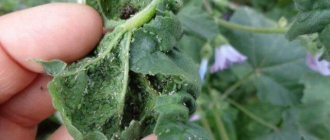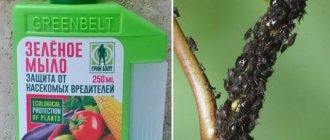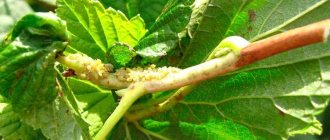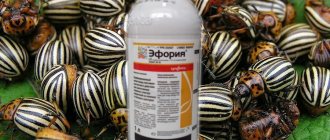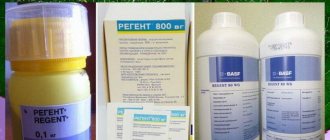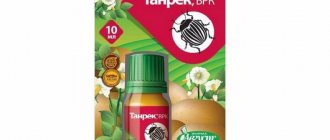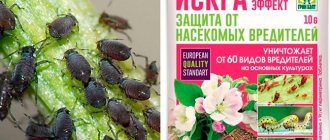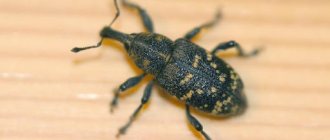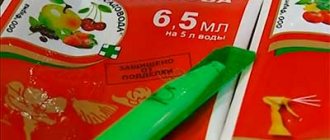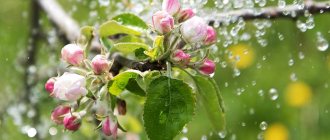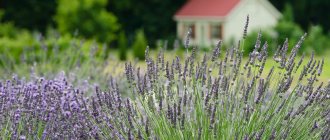Soap solution for aphids, spider mites and fungi
It was used as the simplest and most accessible plant protection product and was widely used in the first half of the 20th century. Soap, due to the large amount of alkali in its composition, has a very high pH value (PH = 11–12), due to which it is a good remedy for fighting insects, as well as various plant diseases. Today one can argue that it was easier to deal with all these misfortunes in the past. Yes, in those days there were no effective insecticides and fungicides, and unwanted macro- and microorganisms had not yet developed, as they do now, defense mechanisms against them, and therefore were less stable.
But, as it turned out, laundry soap is effective to this day. This is due to the chemistry of alkali metal salts of fatty acids, which, when dissociated with water, give a strong alkali, and it is almost impossible to develop protection against it. In addition, the acids themselves are released, which have strong insecticidal properties. For example, it has been proven that caproic acid destroys over 90% of aphids even at a concentration of only 0.2%. Therefore, even a very small amount of soap can effectively protect your garden from such a scourge.
How to prepare a solution of laundry soap against pests
To prepare a soap emulsion against insects, you need to grind 150–300 g of laundry soap - this will dissolve it faster. The resulting powder should be added to a bucket (10 l) of hot water, then stir well. After cooling, you need to make sure that there are no solid particles left in the liquid - they can cause burns to the plants, so it is better to filter it through cheesecloth.
Destruction of aphids and spider mites with soap solution
Soap can be used perfectly against insects with a thin chitinous covering, since viscous fatty acids clog the endings of the trachea - the spiracles - throughout their body and, deprived of oxygen, they die. This method is good against pests such as mealybugs, aphids, spider mites, and caterpillars of various butterflies. It can be used to protect a wide variety of crops.
Soap against parasitic fungi
A solution of laundry soap with a concentration of 0.01–0.1 g per liter can be successfully used to treat or prevent fungal diseases in plants. The drug works especially well against gray mold (Botrytis cinerea). To increase the effectiveness of the soap solution, it is recommended to make it based on plant fertilizers, for example, garlic, tansy, horsetail, comfrey, etc.
The solution described above with this concentration is completely safe for plants, and it can be sprayed on flowers without diluting. But it is not advisable for them to treat plants that are flowering, have recently hatched, or have been planted from seedlings; it is better to test the solution by spraying 1–2 specimens with it. If after 2-3 days there are no burns, then it can be used. Try the soap solution against aphids or other pests - it’s a really cheap and effective plant protection product.
Processing rules
Preparing a working solution is half the battle; you need to use it correctly. The buds and young branches are sprayed against aphids, and they must be sprayed downwards, since aphids settle on the inside of the leaves.
What is important to know:
- for blooming roses, you should not use combined formulations, only soap and water;
- spray regularly.
If the branches of the rose bush are not tall, you can simply dip them into the solution and wash them. I admit that you have found a pest on the bushes when fighting it with folk remedies alone is not effective. But don't rush to buy chemicals.
Safety precautions
Despite the fact that soap poses virtually no threat to humans and animals, it belongs to drugs of the 4th hazard class and it is recommended to carry out all work with the product wearing protective gloves. Do not spray the product near open fire, cigarettes, etc.
According to the instructions, green soap for pests should be prepared in a glass container. If splashes get into the eyes, immediate, thorough rinsing with water and treatment with eye drops is required. The product is washed off the skin under running water.
If the drug ends up in the stomach, it is necessary to induce vomiting, then take a dose of activated charcoal. If necessary, call an ambulance.
- Sale!
How does soap work?
Laundry soap has been used by gardeners in our country for a very long time in pest control. This remedy was used back when chemical insecticides were just emerging. With the help of soap, you can not only drive aphids and ants out of your area, but also defeat some fungal plant diseases. The pest-killing properties of laundry soap are based on the rich content of natural fatty acids in its composition. Scientists have already found out that one of the main components of soap, caproic acid, can kill up to 90% of aphids even in a very weakly concentrated solution.
It will also be useful to learn about what folk methods exist to combat aphids on currants.
Laundry soap is most often used together with other substances in the fight against aphids. Soap in solution is responsible for the insect sticking to the leaf, and substances with a more aggressive toxic composition already complete the procedure, completely destroying the pest.
However, the laundry soap itself has a complex composition, which in the proper concentration can easily kill aphids.
Therefore, highly concentrated solutions of laundry soap can also be used as a separate spraying agent. It will also be useful to learn about how to use tar soap and soda against aphids.
In the video - laundry soap for aphids:
Note that cosmetic soap is not suitable for combating aphids - it is necessary to use laundry soap or tar soap. The fact is that these types of soap have the highest disinfectant and antibacterial properties. In addition, today manufacturers have developed the so-called green soap - a special soap-based insecticide that can, among other things, protect an area from aphids and ants. But you can find out how mustard is used against aphids from the article at the link.
How does laundry soap help fix a natural insecticide?
Laundry soap is a reliable assistant in the fight against pests. Make a decoction or infusion with onion or garlic peels, lemon zest, red pepper, etc. The smell of such an infusion perfectly repels insect pests, but in order for the odorous liquid to linger on the plant, a fixative is needed. Laundry soap is such a fixative.
Recipe: add grated household goods to the infusion. soap (a small amount so as not to burn young plants).
Treating plant leaves with laundry soap will help the plant not to be attacked by garden pests
8. Disinfection of containers and instruments
When pots for indoor plants and containers for seedlings are repeatedly used, pathogenic microorganisms may remain in them, requiring mandatory treatment.
Tool processing (Photo used under standard license ©azbukaogorodnika.ru)
Tool processing (Photo used under standard license ©azbukaogorodnika.ru)
Laundry soap can be used for disinfection. With its help, not only containers are washed, but also all the tools used when caring for plants not only at home, but also in the garden.
Tobacco solution
Making a soap solution for aphids with the addition of tobacco is very simple:
- 200 g of dry leaves are ground into powder and added to a bucket of water;
- grind 3 pods of fresh hot pepper, combine with tobacco solution, leave for 24 hours;
- add 100 g of grated laundry soap, 3 tbsp. spoons of wood ash or cinnamon, mix everything thoroughly.
On a note!
Treatment of plants with soap with the addition of several active components provides high results and quick action.
Fighting spider mites with soap
Laundry soap against spider mites works a little differently, but is also an effective remedy, especially at the initial stage of plant infection. If the pest has settled on indoor plants, soap the sponge and wipe it on the leaves and stems of all window flowers (if the leaves are small and there are many of them, spray them with a soap solution) and leave for 2-4 hours. After this, rinse off the soap in the shower and cover the raw plants with bags. If outdoor crops are affected, prepare a soap solution as for combating aphids and spray all diseased bushes and neighboring plants. Be sure to hose them down with clean water after a few hours.
Spider mites - how to recognize them on plants and fight them effectively The smallest pests sometimes cause us the biggest problems. Spider mites in the garden and vegetable garden are dangerous for all crops.
What to do if pests appear on the plant?
For minor lesions, try to collect the pests by hand, wash them off with water or wipe the leaves with a cotton swab, napkin or soft toothbrush dipped in a soap-alcohol solution.
In more serious cases, use spraying with a soap-alcohol solution and other means (see information on each pest). Repeat the procedures after 1-2 weeks.
How to prepare a soap-alcohol solution
A soap-alcohol solution is used against the following pests : spider mites (in combination with a plant sauna), thrips and aphids (spray 2-3 times).
Mix the following ingredients well until foamy:
- 1 liter of water,
- 1 tbsp. spoon of liquid soap,
- 1 tbsp. spoon of alcohol.
Cover the soil with film to prevent the solution from getting into the soil.
Pour the mixture into a spray bottle and spray the plants on the outside and inside of the leaves. It is most convenient to carry out this procedure in the bathroom.
Place the plant in a bright but not sunny place for 2-3 days. Then rinse it with water at room temperature. If necessary, repeat the procedure after a week.
Prevention of fungal diseases
Using laundry soap you can resist fungal diseases. The solution allows you to fight gray mold (Botrytis cinerea), which most often affects strawberries, cabbage, onions, cherries, peppers and other crops. At the initial stage, you can detect a light gray coating. Soon it begins to actively spread, all parts of the plants become lethargic, rot and fall off. Plants can be protected from this disease by treating them with a soap-based solution. Grate half a block and dilute the shavings in 10 liters of water. To enhance the effect of the composition, it can be supplemented with tansy or garlic extract. Treat every 2 weeks. A total of 3 such procedures will be required.
Loading …
Green soap
On many country websites and forums you can find a lot of information about green soap. It is used not only to protect cultivated plants from pests, but also to prevent many diseases.
For a standard 10 liter bucket of water, take 250 g of green soap. Add an additional 20 g of mustard powder to the resulting mixture. You can also add a little copper sulfate.
Plants can be treated with the resulting composition no more than 3 times during the summer season.
What are the benefits of iodine and milk for cucumbers?
Using milk with iodine avoids chemical supplements
Iodine is a powerful antiseptic and contains many trace elements . And this has a beneficial effect on the growth of cucumbers and prevents the development of the following diseases:
In addition, iodine improves the appearance of the plant.
Milk also contains enough beneficial elements to prevent nutritional deficiencies in the plant. Milk also extinguishes the activity of pathogenic fungi. Therefore, the combination of milk with iodine has a double effect in terms of protecting and nourishing the culture.
Disease prevention in plants should begin as soon as 5–6 full-fledged leaves are formed on the seedlings. Repeat the procedure every two weeks. Then disease outbreaks can be avoided. Iodine with milk will be useful not only for cucumbers, but also for other crops:
For seedlings, such feeding is absolutely safe if you adhere to the dosage. Thanks to it, plant immunity increases. The only thing is that it is recommended not to treat the seedlings with a milk-iodine composition externally - only apply at the roots. This is due to the ability of iodine to cause burns to young foliage.
Video: benefits of iodine in milk for cucumber crops
Wood ash
Everyone knows that ash is used as a good fertilizer for soil fertility. When properly prepared, ash turns into a good means of combating aphids, as well as a number of other insects. Ash can be used in different forms.
For example, the solution is prepared as follows. The sifted ash needs to be boiled in 300 ml of water, thereby you will get an ash solution against aphids. After this, you need to strain it and stir it in a bucket of water. Ash helps especially well with the appearance of aphids on trees!
First, shower them and wet the leaves, and then “powder” them. In addition, fertilizing with ash itself is an excellent preventive measure. Due to its high potassium content, ash eliminates excess nitrogen in the soil, destroying the environment for aphids to live and reproduce.
Additional Recipes
In addition to the above methods, there are other folk recipes that also help destroy insects.
With wood ash
Wood ash can also be used with soap, which adds effectiveness in the fight against aphids. You can make a solution with these substances by following these steps:
- The ash is sifted through a sieve. This separates large elements that are not needed in the solution. In total you need to prepare 300 grams.
- Fill a metal container with 10 liters of water, pour ash into it and place it on the stove.
- Bring the solution to a boil, then cook for 30 minutes.
- Cool the resulting liquid and stir 40 grams of grated soap into it.
Important! Ash and soap against aphids are not used when plants form flowers. Getting the ash solution on the buds will repel pollinating insects. Those plants that are in the period of peduncle formation should be sprayed with soap foam.
With baking soda
To prepare this remedy, you must do the following:
- Take a tablespoon of soda, preferably with a heap, and a quarter of solid soap, which you need to grate on a coarse grater.
- Mix the ingredients and place them in a metal container. Pour a liter of boiling water.
- Stir until a homogeneous mass is obtained.
- Dilute the solution with cold water. After this, you can start using the product.
Tobacco
Aphids and many other pests do not tolerate strong-smelling substances. That is why adding tobacco to the aphid mixture will bring additional benefits - it will rid the bushes of caterpillars and mites. To properly make a concentrate, you must perform the following steps:
- Take 200 grams of dry tobacco. Grind the ingredient into a fine substance and add to a bucket of previously prepared boiled water.
- Pour the grated soap into the same container and stir the substance.
- To enhance the effect, you can add hot pepper to the solution.
With tomato or potato tops
This recipe is also used by gardeners in the fight against harmful insects. By following the instructions, you can prepare the product correctly.
- Finely chop 4 kg of potato or tomato tops. Place it in a metal container.
- Pour 10 liters of water into the raw material and let it brew for 4-6 hours.
- After this time, put the solution on the fire and bring it to a boil.
- Add 50 grams of grated solid soap to the resulting mixture. Mix everything and strain.
Oil
When using this method, you need to take vegetable oil and laundry soap in equal proportions:
- A glass of oil and a glass of grated soap are added to a bucket of water.
- The substances are mixed and beaten until the soap is completely dissolved.
- After this, you can use the mixture to spray plants or feed the soil.
The usefulness of the oil lies in keeping the solution on the leaves for a long time. Therefore, the effectiveness and service life of the aphid repellent increases significantly.
Pine extract
This component is sold in salt or powder form. Many gardeners use it, as it is a proven and safe substance for plants. You can prepare the solution by following the rules:
- Dilute 4 tablespoons of concentrate in a bucket of water.
- Add grated soap to the container and stir the mixture.
- Let the liquid sit for 30-40 minutes. After this, you can start spraying.
Attention! You can spray plants with a soap-based solution only after pre-cooling the substance.
Alternative milk-iodine options
Any feeding solutions with iodine are an effective preventative for cucumbers.
Common iodine solutions:
If you don’t have iodine on hand, you can replace it with brilliant green (it has similar properties). To prepare the fertilizer, you will need to mix eight liters of water with two liters of whey or low-fat kefir and add 1 pharmacy bottle (10 ml) of brilliant green.
After iodine-milk feeding, cucumber seedlings grow strong and healthy
To protect seedlings from late blight, prepare the following remedy:
Another remedy increases the resistance of plants to late blight: add sifted ash powder (2 kg) to boiling water (8 l), mix and allow to cool. Then add a bottle of iodine and 15 g of boric acid. After this, you need to let the mixture brew for 10 hours. Water the cucumbers at the root, having previously diluted the liquid with water in a ratio of 1:10. As a result of processing cucumbers with this composition, protection and replenishment with microelements is provided.
Mealybug
It is a sucking insect covered with a white waxy coating. It got its name because of the characteristic white discharge, similar to cotton wool. The size of the insect, depending on the variety, varies from 0.5 to 12 mm. The mealybug has well-developed sexual dimorphism.
Males have wings and well-developed limbs, and tail processes are visible on the abdomen. Due to the fact that adult males do not feed, they do not have a mouth.
The females of most species lay eggs, but some species are viviparous. The eggs are placed in white cocoons made of wax threads. The fertility of the mealybug is very high - some females are capable of producing up to 4 generations per year.
The first instar larvae are able to actively move around the plant, but after sucking on, they lose mobility. The ability to move is restored after molting.
Scale insects harm the plant by sucking its juices. Because of this, the growth of the plant stops, and then its death occurs.
Signs of defeat
The presence of a mealybug is easily recognized by the presence of a waxy, cottony coating on the plant. Another sign may be a special sugary discharge and a fungus settling on it.
Control measures
In case of a mild form of infection, it is enough to clean the plant from insects and their waxy secretions using a soft brush and soap solution. Then the flower is sprayed with garlic infusion, green soap solution or cyclamen decoction. The spraying procedure must be carried out 3 times every 7 days. A good effect can be obtained by treating the plant with alcohol tincture of calendula or regular alcohol.
If the damage is quite serious, then in addition to mechanical impact on the pest, that is, manual collection, the plant will need to be sprayed with solutions of the following chemicals: Aktara, Fitoverm, Calypso, Confidor, Tanrek.
What harm does aphids cause?
A small yellow, greenish or even black insect likes to feast on the tender leaves of plants, mainly in the warm season. If you look closely at the flowers, the pests can be seen with the naked eye, since the individuals are quite large, the body reaches 2 mm in length. A nuisance for the amateur gardener is the colonial invasion of aphids, a massive destruction of flowering plants.
Having settled on plants, aphids lead a sedentary lifestyle. She sucks the juice from young shoots by piercing the tender parts of the plant with her small proboscis. As a result of the active activity of insects, indoor flowers weaken, do not grow, become diseased and die.
Signs of plant damage by aphids:
- Curled leaves.
- Deformed tops and young shoots.
- The buds curl and fall off.
- Transparent droplets appear on the leaves, similar to honey.
Aphids cause irreparable harm to the plant, because the insect is a carrier of many infections, so affected indoor flowers are exposed to all sorts of diseases.
Instructions for use
Efficiency of soap solution The fight against aphids is carried out by spraying.
Small bushes of plants are watered from a watering can. For spraying, use a garden sprayer and bottles with a nozzle. During treatment, you should try to ensure that the stream hits the lower part of the plant, since this is where the pests are concentrated. Otherwise, the solution will flow to the ground without getting on the aphids.
On a note!
The frequency of application depends on the degree of damage to the garden plot. The activity begins at the first signs of crop damage and is repeated every week for prevention. Destruction is carried out in several procedures with a break of 2-3 days.
Soap solution for flowers against pests and diseases
Do you use soap solution against aphids and many other plant pests and diseases? If not, then in vain. After all, working in the country and communicating with our colleagues, we are increasingly observing an interesting trend - old, sometimes forgotten methods in gardening for many years, used by our grandmothers and great-grandmothers, are becoming again in demand. One of these technologies is the use of laundry soap in the garden to counteract diseases and pests.
Soap solution for aphids, spider mites and fungi
It was used as the simplest and most accessible plant protection product and was widely used in the first half of the 20th century. Soap, due to the large amount of alkali in its composition, has a very high pH value (PH = 11–12), due to which it is a good remedy for fighting insects, as well as various plant diseases. Today one can argue that it was easier to deal with all these misfortunes in the past. Yes, in those days there were no effective insecticides and fungicides, and unwanted macro- and microorganisms had not yet developed, as they do now, defense mechanisms against them, and therefore were less stable.
But, as it turned out, laundry soap is effective to this day. This is due to the chemistry of alkali metal salts of fatty acids, which, when dissociated with water, give a strong alkali, and it is almost impossible to develop protection against it. In addition, the acids themselves are released, which have strong insecticidal properties. For example, it has been proven that caproic acid destroys over 90% of aphids even at a concentration of only 0.2%. Therefore, even a very small amount of soap can effectively protect your garden from such a scourge.
How to prepare a solution of laundry soap against pests
To prepare a soap emulsion against insects, you need to grind 150–300 g of laundry soap - this will dissolve it faster. The resulting powder should be added to a bucket (10 l) of hot water, then stir well. After cooling, you need to make sure that there are no solid particles left in the liquid - they can cause burns to the plants, so it is better to filter it through cheesecloth.
Destruction of aphids and spider mites with soap solution
Soap can be used perfectly against insects with a thin chitinous covering, since viscous fatty acids clog the endings of the trachea - the spiracles - throughout their body and, deprived of oxygen, they die. This method is good against pests such as mealybugs, aphids, spider mites, and caterpillars of various butterflies. It can be used to protect a wide variety of crops.
Soap against parasitic fungi
A solution of laundry soap with a concentration of 0.01–0.1 g per liter can be successfully used to treat or prevent fungal diseases in plants. The drug works especially well against gray mold (Botrytis cinerea). To increase the effectiveness of the soap solution, it is recommended to make it based on plant fertilizers, for example, garlic, tansy, horsetail, comfrey, etc.
The solution described above with this concentration is completely safe for plants, and it can be sprayed on flowers without diluting. But it is not advisable for them to treat plants that are flowering, have recently hatched, or have been planted from seedlings; it is better to test the solution by spraying 1–2 specimens with it. If after 2-3 days there are no burns, then it can be used. Try the soap solution against aphids or other pests - it’s a really cheap and effective plant protection product.
Reviews
A neighbor in the country waters her cucumbers with milk diluted with water. She likes cucumbers too, they never make her sick.
Antonina
https://agrognom.ru/vegetables/kak-podkarmlivat-ogurtsy-molokom-i-jodom.html
All my friends have gotten used to watering their cucumbers with whey, there are benefits, the cucumbers receive nitrogen nutrition. It is provided by amino acids and peptides. In addition, whey contains lactic acid. Thanks to it, the soil is slightly acidified, making it easier for cucumbers to consume microelements. Lactose, which is in whey, enhances the growth of microorganisms, and they, in turn, improve the consumption of microelements.
Vladimir
https://agrognom.ru/vegetables/kak-podkarmlivat-ogurtsy-molokom-i-jodom.html
One of my good friends has been processing cucumbers with milk for a hundred years. She worked as an agronomist during Soviet times. Their dacha always produces more cucumbers than their neighbors.
Ivan
https://agrognom.ru/vegetables/kak-podkarmlivat-ogurtsy-molokom-i-jodom.html
According to numerous reviews from gardeners, iodine-milk treatment helps protect cucumber plantings from diseases and pests, improves the appearance of the plant and improves the quality of the harvest. The method is absolutely safe for both plants and humans.
Source
Soap solution for aphids, spider mites and fungi
It was used as the simplest and most accessible plant protection product and was widely used in the first half of the 20th century. Soap, due to the large amount of alkali in its composition, has a very high pH value (PH = 11–12), due to which it is a good remedy for fighting insects, as well as various plant diseases. Today one can argue that it was easier to deal with all these misfortunes in the past. Yes, in those days there were no effective insecticides and fungicides, and unwanted macro- and microorganisms had not yet developed, as they do now, defense mechanisms against them, and therefore were less stable.
But, as it turned out, laundry soap is effective to this day. This is due to the chemistry of alkali metal salts of fatty acids, which, when dissociated with water, give a strong alkali, and it is almost impossible to develop protection against it. In addition, the acids themselves are released, which have strong insecticidal properties. For example, it has been proven that caproic acid destroys over 90% of aphids even at a concentration of only 0.2%. Therefore, even a very small amount of soap can effectively protect your garden from such a scourge.
How to prepare a solution of laundry soap against pests
To prepare a soap emulsion against insects, you need to grind 150–300 g of laundry soap - this will dissolve it faster. The resulting powder should be added to a bucket (10 l) of hot water, then stir well. After cooling, you need to make sure that there are no solid particles left in the liquid - they can cause burns to the plants, so it is better to filter it through cheesecloth.
Destruction of aphids and spider mites with soap solution
Soap can be used perfectly against insects with a thin chitinous covering, since viscous fatty acids clog the endings of the trachea - the spiracles - throughout their body and, deprived of oxygen, they die. This method is good against pests such as mealybugs, aphids, spider mites, and caterpillars of various butterflies. It can be used to protect a wide variety of crops.
Soap against parasitic fungi
A solution of laundry soap with a concentration of 0.01–0.1 g per liter can be successfully used to treat or prevent fungal diseases in plants. The drug works especially well against gray mold (Botrytis cinerea). To increase the effectiveness of the soap solution, it is recommended to make it based on plant fertilizers, for example, garlic, tansy, horsetail, comfrey, etc.
The solution described above with this concentration is completely safe for plants, and it can be sprayed on flowers without diluting. But it is not advisable for them to treat plants that are flowering, have recently hatched, or have been planted from seedlings; it is better to test the solution by spraying 1–2 specimens with it. If after 2-3 days there are no burns, then it can be used. Try the soap solution against aphids or other pests - it’s a really cheap and effective plant protection product.
